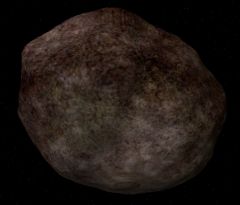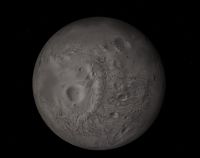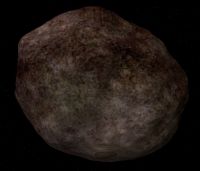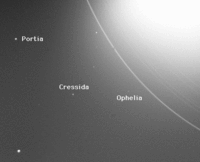Difference between revisions of "Cressida"
m |
(Added content.) |
||
| (21 intermediate revisions by the same user not shown) | |||
| Line 1: | Line 1: | ||
| − | + | {| cellpadding="2" cellspacing="0" style="margin:25px 0 0 10px; border:3px solid lightsteelblue;width:250px; font-size:90%; font-family:'Arial','Helvetica'; float: right; clear: right;"Template in Orbiter" | |
| − | + | !bgcolor="lightsteelblue" colspan="2" align="center" |Cressida | |
| − | + | |- | |
| − | + | |colspan="2" align="center"|[[Image:Cressida-UranusMoonszip-Orbiter2003P2.jpg|240px]] | |
| − | + | |- | |
| − | == | + | |colspan="2" align="center"|<center>'''Cressida from ''UranusMoons.zip'' in Orbiter 2003P2'''</center> |
| − | + | |- | |
| − | + | !bgcolor="lightsteelblue" colspan="2"|Designation | |
| − | + | |- | |
| − | + | |Name||align="right"|Cressida | |
| − | + | |- | |
| − | + | |width="30%"|Reference body||align="right" width="30%"|Uranus | |
| − | + | |- | |
| − | == | + | !bgcolor="lightsteelblue" colspan="2"|Planetary mean orbits |
| − | + | |- | |
| − | + | |width="30%"|Epoch||align="right" width="50%"|2006 | |
| − | + | |- | |
| − | + | |width="30%"|Semimajor axis (a)||align="right" width="50%"|61822499.4052205 m | |
| − | + | |- | |
| − | + | |width="30%"|Eccentricity (e)||align="right" width="30%"|0.000744267621633336 | |
| − | |||
| − | |||
| − | |||
| − | |||
| − | |||
| − | |||
| − | |||
| − | |||
| − | |||
| − | |||
| − | |||
| − | |||
| − | |||
| − | |||
| − | == | ||
| − | |||
|- | |- | ||
| − | + | |width="30%"|Inclination (i)||align="right" width="30%"|97.72720281° <br> (1.70566145779382 radian) | |
|- | |- | ||
| − | | | + | |width="30%"|Longitude of the ascending node (LAN, ☊)||align="right" width="30%"|167.6480124° <br> (2.92600980084555 radian) |
|- | |- | ||
| − | | | + | |width="30%"|Longitude of periapsis (ϖ)||align="right" width="30%"|290.5350633° <br> (5.07079344631496 radian) |
|- | |- | ||
| − | | | + | |width="30%"|Mean longitude (L)||align="right" width="30%"|627.7866981° <br> (10.9569448828597 radian) |
|- | |- | ||
| − | | | + | !bgcolor="lightsteelblue" colspan="2"|Selected physical parameters |
|- | |- | ||
| − | | | + | |width="30%"|Mean radius||align="right" width="30%"|32970 m |
|- | |- | ||
| − | | | + | |width="30%"|Mass||align="right" width="30%"|2.262×10<sup>16</sup> kg |
|- | |- | ||
| − | | | + | |width="30%"|SidRotPeriod||align="right" width="30%"|40089.6 (11.136 hours) |
|- | |- | ||
| − | | | + | |width="30%"|SidRotOffset||align="right" width="30%"|0 |
|- | |- | ||
| − | | | + | |width="30%"|Obliquity||align="right" width="30%"|1.4346 |
|- | |- | ||
| − | | | + | |width="30%"|LAN||align="right" width="30%"|2.9255 |
|- | |- | ||
| − | | | + | |width="30%"|Note||align="right" width="30%"|*Elements given are from Cressida.cfg (UranusMoons.zip) |
|} | |} | ||
| − | + | '''Cressida (Uranus IX, S/1986 U 3)''' is one of the inner satellites of [[Uranus]]. It was discovered by the [[w:Voyager 2|Voyager2]] spacecraft in January 1986. It is named after the [[w:Trojan|Trojan]] daughter of Calchas in [[w:William Shakespeare|Shakespeare's]] [[w:Troilus and Cressida|Troilus and Cressida]]. | |
| − | + | ||
| − | + | == Portia in Orbiter == | |
| − | + | Cressida was first introduced into Orbiter with the add-on ''uranus.zip'' in November 2002. | |
| − | | | ||
| − | |||
| − | |||
| − | |||
| − | |||
| − | |||
| − | |||
{|class="wikitable sortable” style="text-align: center" | {|class="wikitable sortable” style="text-align: center" | ||
|- | |- | ||
| − | !Add-on!!Version!! | + | |colspan="8"|<center>'''Orbiter versions and add-ons which include Portia'''</center> |
| − | + | |- | |
| − | + | !Add-on!!Source!!Version!!Author!!Type!!Release Date!!Compatibility!!Wiki article | |
| − | + | |- | |
| − | + | |[https://www.orbiter-forum.com/resources/uranus-minor-moons.1765/ Uranus Minor Moons]||O-F Resources||2004-12-14||Nighthawke||Scenery||14 December 2004|||| | |
| − | + | |- | |
| − | + | |[https://library.avsim.net/esearch.php?DLID=&Name=&FileName=uranus.zip&Author=&CatID=root Uranus]||AVSIM||||Rolf Keibel||Scenery||5 November 2002|||| | |
| − | + | |} | |
| − | == | ||
| − | |||
| − | |||
| − | + | <gallery widths="200" heights="200"> | |
| + | Cressida-uranuszip.jpg|<center>Portia from ''uranus.zip'' in Orbiter 2002</center> | ||
| + | Cressida-UranusMoonszip-Orbiter2003P2.jpg|<center>Cressida from ''UranusMoons.zip'' in Orbiter2003P2</center> | ||
| + | Cressida enhanced Southern skies-2.png|<center>Cressida imaged by the [[w:Voyager 2|Voyager 2]] spacecraft in 1986,<br>from Wikimedia Commons</center> | ||
| + | Uranus-Portia-Cressida-Ophelia-NASA.gif|<center>Voyager 2 image of [[Portia]], Cressida, and [[Ophelia]],<br>from Wikimedia Commons</center> | ||
| + | </gallery> | ||
| − | + | {{UranusSat}} | |
| + | {{SolarSystem}} | ||
| − | + | [[Category:Articles]] | |
| − | + | [[Category:Celestial bodies]] | |
| − | + | [[Category:Solar System]] | |
| − | + | [[Category:Natural satellites]] | |
| − | + | [[Category:Satellites of Uranus]] | |
| − | |||
| − | |||
| − | |||
| − | + | {{Nsat-Stub}} | |
Revision as of 02:40, 15 September 2024
Cressida (Uranus IX, S/1986 U 3) is one of the inner satellites of Uranus. It was discovered by the Voyager2 spacecraft in January 1986. It is named after the Trojan daughter of Calchas in Shakespeare's Troilus and Cressida.
Portia in Orbiter
Cressida was first introduced into Orbiter with the add-on uranus.zip in November 2002.
| Add-on | Source | Version | Author | Type | Release Date | Compatibility | Wiki article |
|---|---|---|---|---|---|---|---|
| Uranus Minor Moons | O-F Resources | 2004-12-14 | Nighthawke | Scenery | 14 December 2004 | ||
| Uranus | AVSIM | Rolf Keibel | Scenery | 5 November 2002 | |||
Cressida imaged by the Voyager 2 spacecraft in 1986,
from Wikimedia Commons
| Uranus's natural satellites |
|---|
| Named Satellites:
Ariel | Belinda | Bianca | Caliban | Cordelia | Cressida | Cupid | Desdemona | Ferdinand | Francisco | Juliet | Mab | Margaret | Miranda | Oberon | Ophelia | Perdita | Portia | Prospero | Puck | Rosalind | Setebos | Stephano | Sycorax | Titania | Trinculo | Umbriel Numbered Satellites: |
| See also: Pronunciation key | rings of Uranus |
| edit The Solar System | |
|---|---|
| Central star |
Sun (Sol) |
| Planets |
Mercury - Venus - Earth - Mars - Jupiter - Saturn - Uranus - Neptune |
| Natural satellites |
Moon - Phobos - Deimos - Io - Europa - Ganymede - Titan - more... |
| Add-ons |
Planets - Dwarf Planets - Small objects - Natural satellites - Alternative star systems |
 | This natural satellite related article is a stub. You can help Orbiterwiki by expanding it.
|




